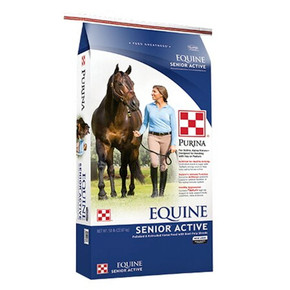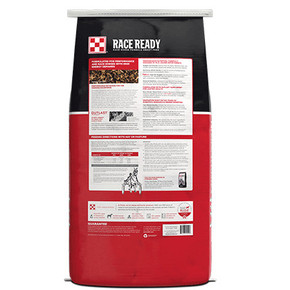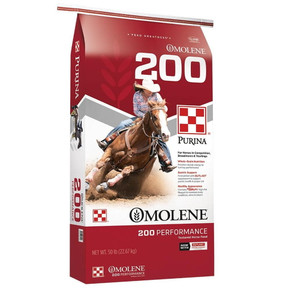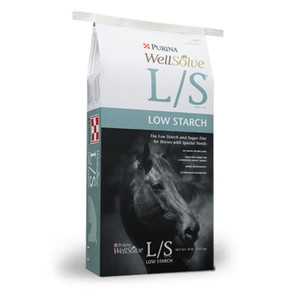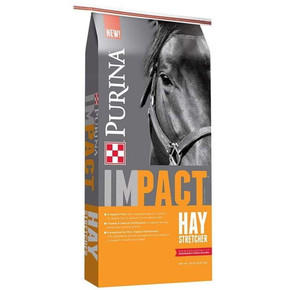
Purina Equine Junior Horse Feed - 50 lb
You know your horse's first years are very important. Proper growth and development depend upon strong genetics, a nurturing environment, and good nutrition.
That's why the Ph.D. Equine nutritionists at the purina animal nutrition center formulated purina equine junior horse feed to take the guesswork out of feeding your growing horse. The formula was developed to give your young horse a strong head start with the proper balance of nutrients to promote optimal growth and development. And because purina equine junior horse feed is a complete feed with high-quality forage built-in, it eliminates nutrient variability of hay or pasture and promotes a consistent diet for weanlings and yearlings.
Equine junior horse feed is formulated with purina's proprietary high-fat amplify nugget a blend of vegetable oils, flaxseed, and rice bran for an optimal fatty acid profile to support development, shine, and bloom.
Features
- Complete feed with high-quality hay built-in - to address nutrient variability of hay or pasture and promote consistent nutrient intake, providing a consistent diet for growing horses
- Vitamin & mineral fortification - designed to meet the specific nutritional needs of the growing horse. Based on nutrient requirements of horses, sixth revised edition, 2007, published by the national research council
- Purina amplify high-fat nugget - a proprietary blend of vegetable oils, flaxseed, and rice bran for an optimal fatty acid profile to support development, shine, and bloom
- Combined energy sources - a precise blend of fats, fibers and soluble carbohydrates helps promote a steady growth rate
- Highly digestible proteins - nutrient-dense, easily-digested pellets, and extruded nuggets are well-suited for a growing horse's digestive system
- The targeted amino acid profile - high-quality protein sources selected for an optimal amino acid profile to support proper development of muscle, bone, skin, hair, and hooves
- Complete feed - high-quality hay built in to provide growing horses the fiber they need
- Highly palatable with less sugar - instead of using straight cane molasses, which is higher in sugar, purina equine junior horse feed contains a unique blend of molasses and soy for a higher fat molasses the encourages optimal intake
Nutrients
- Crude Protein (min): 14.50 %
- Lysine (min): 0.80 %
- Methionine (min): 0.25 %
- Threonine (min): 0.55 %
- Crude Fat (min): 5.50 %
- Crude Fiber (max): 16.00 %
- Acid Detergent Fiber (ADF) (max): 22.00 %
- Neutral Detergent Fiber (NDF) (max): 38.00 %
- Starch (max): 14.00 %
- Sugars (max): 9.00 %
- Calcium (Ca) (min): 0.80 %
- Calcium (Ca) (max): 1.30 %
- Phosphorus (P) (min): 0.55 %
- Copper (Cu) (min): 60.00 PPM
- Selenium (Se) (min): 0.30 PPM
- Zinc (Zn) (min): 220.00 PPM
- Vitamin A (min): 3500 IU/lb
- Vitamin D3 (min): 600 IU/lb
- Vitamin E (min): 150 IU/lb
Feeding Directions
Description
Start with the amounts given for the weight and lifestyle of the horse. After observing the horse for a period of time, the amount fed may be increased or decreased by 10% to obtain the desired body condition and weight.
Recommended feeding rates may need to be adjusted 10 to 15% to keep a horse in peak condition.
Best Results
- Equine junior horse feed is designed to be fed as a complete feed. If necessary, you may also feed with good-quality hay or pasture, up to a maximum of 5 lb per day, to relieve boredom
- You should reduce the amount of equine junior horse feed fed by 1 lb for every 1.5 to 2 lb of hay offered
- For best results, do not feed more than 1 lb of hay per 100 lb of your horse's body weight when feeding equine junior horse feed
- Feeding rates will vary with size, age, temperament, health status, climate, and activity level. Feed at regular times - at least twice daily - with three daily feedings preferred. Let horses feed in a natural position from troughs with large bottoms, placed at normal head height or lower
- Do not feed free choice. Prevent the rapid eating by the horse of any feedstuff
- Reduce and/or delay feeding a horse that is hot, excited, or showing pain, has a fever, or diarrhea. Consult your veterinarian if any problems arise
- Any feed changes should be made gradually over a period of 7 to 10 days. Changes in the rate of feeding should not exceed 1.0 lb per day for each horse
- Have plenty of clean, fresh water available at all times. Provide your horse with access to salt. Maintain an effective control program for internal parasites. Have the horse's teeth examined annually and consult your veterinarian on a regular basis
Changing to
- Make the feed change gradually over a period of 7 to 10 days
- Mix the new feed with the old, gradually increasing the amount of the new feed while decreasing an equal amount of the old.
- Changes in the rate of feeding should not exceed 1 pound per day for each horse
Caution
Store in a dry, well-ventilated area protected from rodents and insects. Do not feed moldy or insect-infested feed to animals as it may cause illness, performance loss, or death.
Specifications
- Size: 50 lb
- Life Stage: Breeding & Growing
- Type: Complete Feed
- Form: Pelleted & Extruded
You know your horse's first years are very important. Proper growth and development depend upon strong genetics, a nurturing environment, and good nutrition.
That's why the Ph.D. Equine nutritionists at the purina animal nutrition center formulated purina equine junior horse feed to take the guesswork out of feeding your growing horse. The formula was developed to give your young horse a strong head start with the proper balance of nutrients to promote optimal growth and development. And because purina equine junior horse feed is a complete feed with high-quality forage built-in, it eliminates nutrient variability of hay or pasture and promotes a consistent diet for weanlings and yearlings.
Equine junior horse feed is formulated with purina's proprietary high-fat amplify nugget a blend of vegetable oils, flaxseed, and rice bran for an optimal fatty acid profile to support development, shine, and bloom.
Features
- Complete feed with high-quality hay built-in - to address nutrient variability of hay or pasture and promote consistent nutrient intake, providing a consistent diet for growing horses
- Vitamin & mineral fortification - designed to meet the specific nutritional needs of the growing horse. Based on nutrient requirements of horses, sixth revised edition, 2007, published by the national research council
- Purina amplify high-fat nugget - a proprietary blend of vegetable oils, flaxseed, and rice bran for an optimal fatty acid profile to support development, shine, and bloom
- Combined energy sources - a precise blend of fats, fibers and soluble carbohydrates helps promote a steady growth rate
- Highly digestible proteins - nutrient-dense, easily-digested pellets, and extruded nuggets are well-suited for a growing horse's digestive system
- The targeted amino acid profile - high-quality protein sources selected for an optimal amino acid profile to support proper development of muscle, bone, skin, hair, and hooves
- Complete feed - high-quality hay built in to provide growing horses the fiber they need
- Highly palatable with less sugar - instead of using straight cane molasses, which is higher in sugar, purina equine junior horse feed contains a unique blend of molasses and soy for a higher fat molasses the encourages optimal intake
Nutrients
- Crude Protein (min): 14.50 %
- Lysine (min): 0.80 %
- Methionine (min): 0.25 %
- Threonine (min): 0.55 %
- Crude Fat (min): 5.50 %
- Crude Fiber (max): 16.00 %
- Acid Detergent Fiber (ADF) (max): 22.00 %
- Neutral Detergent Fiber (NDF) (max): 38.00 %
- Starch (max): 14.00 %
- Sugars (max): 9.00 %
- Calcium (Ca) (min): 0.80 %
- Calcium (Ca) (max): 1.30 %
- Phosphorus (P) (min): 0.55 %
- Copper (Cu) (min): 60.00 PPM
- Selenium (Se) (min): 0.30 PPM
- Zinc (Zn) (min): 220.00 PPM
- Vitamin A (min): 3500 IU/lb
- Vitamin D3 (min): 600 IU/lb
- Vitamin E (min): 150 IU/lb
Feeding Directions
Description
Start with the amounts given for the weight and lifestyle of the horse. After observing the horse for a period of time, the amount fed may be increased or decreased by 10% to obtain the desired body condition and weight.
Recommended feeding rates may need to be adjusted 10 to 15% to keep a horse in peak condition.
Best Results
- Equine junior horse feed is designed to be fed as a complete feed. If necessary, you may also feed with good-quality hay or pasture, up to a maximum of 5 lb per day, to relieve boredom
- You should reduce the amount of equine junior horse feed fed by 1 lb for every 1.5 to 2 lb of hay offered
- For best results, do not feed more than 1 lb of hay per 100 lb of your horse's body weight when feeding equine junior horse feed
- Feeding rates will vary with size, age, temperament, health status, climate, and activity level. Feed at regular times - at least twice daily - with three daily feedings preferred. Let horses feed in a natural position from troughs with large bottoms, placed at normal head height or lower
- Do not feed free choice. Prevent the rapid eating by the horse of any feedstuff
- Reduce and/or delay feeding a horse that is hot, excited, or showing pain, has a fever, or diarrhea. Consult your veterinarian if any problems arise
- Any feed changes should be made gradually over a period of 7 to 10 days. Changes in the rate of feeding should not exceed 1.0 lb per day for each horse
- Have plenty of clean, fresh water available at all times. Provide your horse with access to salt. Maintain an effective control program for internal parasites. Have the horse's teeth examined annually and consult your veterinarian on a regular basis
Changing to
- Make the feed change gradually over a period of 7 to 10 days
- Mix the new feed with the old, gradually increasing the amount of the new feed while decreasing an equal amount of the old.
- Changes in the rate of feeding should not exceed 1 pound per day for each horse
Caution
Store in a dry, well-ventilated area protected from rodents and insects. Do not feed moldy or insect-infested feed to animals as it may cause illness, performance loss, or death.
Specifications
- Size: 50 lb
- Life Stage: Breeding & Growing
- Type: Complete Feed
- Form: Pelleted & Extruded



